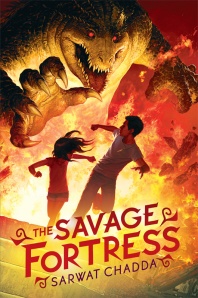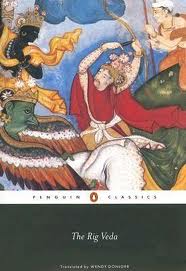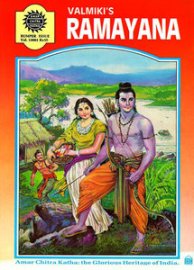 The Savage Fortress by Sarwat Chadda
The Savage Fortress by Sarwat Chadda
US Pub Date: October 2012
Publisher: Arthur A. Levine (Scholastic)
Level: Middle Grade (ages 11+)
Digital copy purchased for review.
I can’t believe it took me THIS long to discover Sarwat Chadda’s The Savage Fortress! Y’all, this book is BANANAS! Bah-nah-nuhs, I tell you! Thanks to Cindy, who first told me about it, I devoured this book in 2 days last week. For those of you who don’t think that’s impressive reading, trust me, it is, for a busy mom of two hyper boys under age 5. For reals.
13-year old Ash (Ashoka) Mistry and his younger sister, Lucky (Lakshmi) have traveled from London to see their Uncle Vik(ram) and Aunt Anita for the summer in Varanasi, India. Ash is a mythology buff particularly fascinated by the Hindu epic The Ramayana–he’s hoping that Uncle Vik (a scholar on ancient Indian history) will give him a first-hand look at India and its rich culture. Uncle Vik has also been hired by the wealthy, but odd Lord Alexander Savage to translate a Harappan-language scroll discovered in a recent archaeological dig in Rajasthan. Unbeknownst to Vik, Savage plans on using the scroll to resurrect Ravana, the demon king from the Hindu epic The Ramayana.
During an evening picnic at an excavation site near Savage’s castle, Ash stumbles into an underground chamber and discovers a statue of Rama (the hero of The Ramayana); Ash pricks himself on Rama’s arrow (aastra), and that’s when sh*t gets real. Ash sees his worst nightmares coming true – people close to him die, and rakshasas (flesh-eating demons) lurk at every turn. With the aid of Rishi, a badass sadhu (holy man) and Parvati, half-human/half-snake rakshasa girl, Ash and Lucky must fight the ultimate battle between good and evil.
Okay, so it’s obvious that I loved this book. I grew up hearing and reading stories from The Ramayana, and even took college courses on Hinduism. For Hindus, this text is deeply ingrained in our religious and social conscience. I felt a mixture of pride and curiosity, hearing about a book that: 1. Is released by a mainstream publisher; 2. Contains lead characters of South Asian descent; and 3. Makes Indian culture appealing to reluctant readers!
Beyond the fantasy elements of rakshasas, aastras, avatars, and death-eating goddesses, at its heart, The Savage Fortress is about the confusing landscape of adolescence. Ash feels in-between in more ways than one – he’s not really a kid/not really a teen, not English-enough/not Indian-enough. Ash is relatable to most of us who, at some point or another (doesn’t matter about your gender or cultural background), have walked in his shoes. The Savage Fortress is about making choices and not being consigned to the roles/perceptions defined by others. Ash ultimately decides that he is Indian enough. That he is mature enough to take on the world. Love this kid.
Another thing that struck me is the endearing relationship between Ash and Lucky. They bicker, but Ash would truly lay down his life for his sis. Family duty is a valuable component of Indian culture – older siblings, especially brothers, are duty bound to protect their sisters, and Ash mentions this many times throughout the novel. The fact that his sister is named Lakshmi wasn’t lost on me, either. Rama’s wife, Sita, is an incarnation of the goddess Lakshmi, and she’s kidnapped by Ravana in the epic. Essentially, The Ramayana focuses on getting Sita back. In The Savage Fortress, Chadda makes clever parallels between Rama and Ash’s dilemmas – Rama has to protect his wife and Ash needs to protect his sister.
Chadda is careful not to fall into any dangerous stereotyping about East vs. West – Ash complains about India but it’s clear that he loves being there. His respect is genuine, and that’s refreshing to those of us who tire of hearing about Delhi-belly and jokes about holy cows. There were some things I wondered about, though. Like, are the rakshasas Indian, too? And there is an interesting point to be made about Parvati as a subaltern…
The Savage Fortress’s vivid and bloody descriptions (um, limbs get ripped off…it’s sooooo gross! 😀 ) lend themselves well to a graphic format *cough*graphic novelization*cough*. Personally, I think this book falls nicely in the middle of scholarly texts like Wendy Doniger’s translation of the Rig Veda, and the fun, but completely cheesy (well, the older editions, anyway) Amar Chitra Katha series of comics I grew up reading.
(L to R: Penguin Classic’s The Rig Veda trans. by Wendy Doniger, Amar Chitra Katha version of The Ramayana)
Fans of epic storytelling that effectively incorporates mythology (think Rick Riordan, Michael Scott, and Cindy Pon) will swoop up The Savage Fortress. Best part of all? Chadda is working on the sequel right now! SQUEE!!!






